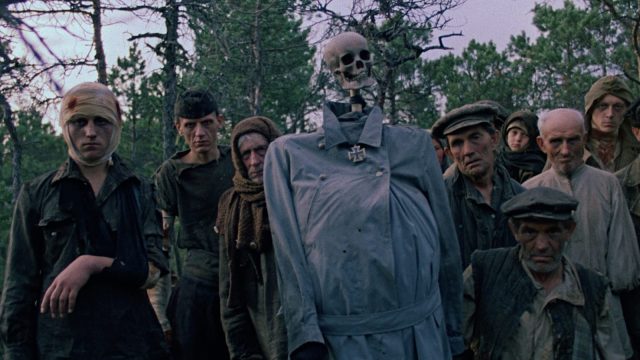Come and See: 1943, by David Bax

Elem Klimov’s 1985 masterpiece Come and See, a new restoration of which opens Friday at the Laemmle Monica Film Center in Santa Monica, seems to have anticipated a 2010s trend by adopting the very hip 1.37:1 aspect ratio. But being cool is the furthest thing from Klimov’s mind. The retro framing instead recalls the earnest but heightened atmosphere of silent cinema. Though shooting in color, Klimov and cinematographer Aleskey Rodionov are classical in their compositions. Important characters are introduced in head-on, medium shot portraiture which is then complemented throughout with close-ups of expressive faces, most notably that of fourteen year old lead actor Aleksey Kravchenko, whose huge doll eyes transform from eagerness to anguish over the course of his character’s soul-draining journey.
It’s 1943 and Flor (Kravchenko) is a poor Belarusian farm boy who enthusiastically–and against his distraught mother’s wishes–joins the Soviet resistance against the encroaching German army after he finds a rifle near his home. Over the course of the next few days, Flor will be tossed and dragged through a panoply of the war’s horrors.
Through it all, he clutches his salvaged rifle like a security blanket. The discovery of the weapon was what emboldened him to join up and, though his disillusionment is drastic and quick, the gun remains a totem of empowerment for him. It’s a false totem, to be sure, as bombs, bullets, grenades and fire rob him of any agency except that which he wields over those even less fortunate than he, like fellow rural Belarusians from whom he steals food and tools.
Experiencing Come and See for the first time in early 2020 makes it impossible not to think of Sam Mendes’ recent 1917. Both films employ long, Steadicam tracking shots in an attempt to create an immersive experience of wartime terror. Only Klimov is successful. Without technical gimmicks and the phony heroics, Come and See offers no comfort or salve for the near-total dehumanization of Flor’s experiences. And, in the supremely distressing and staggeringly choregraphed climax–a small town massacre with a cast of seemingly hundreds playing both victims and brutes–Klimov also preemptively bests another celebrated war film of more recent vintage, László Nemes’ Son of Saul.
Like, say, Joseph Heller before them, Klimov and co-screenwriter Ales Adamovich recognize that war is not just hell, it’s also absurd. There are almost dreamily strange images like new recruit Flor cleaning a massive stewpot from the inside, waist deep in water and covered in herbs like tonight’s dinner. Even the sturm und drang has notes of dark comedy to it, like when Flor’s mother, upon learning of her son’s enlistment, frantically shoves an axe into his hands and insisted he just go ahead and kill her and her daughters now to get it over with.
But the strong notes of horror that are present in Come and See from the very beginning–the scene in which Flor finds the rifle is replete with Lynchian touches like unexplained behavior and ominous ADR–advance to the front as absurdity mutates into nightmare. Flor spends a portion of the film half-deaf from explosions. The mix of ringing and muffled buzzes on the soundtrack are disquieting in the extreme. But perhaps the most haunting use of sound design comes in that intense climax, when the SS annihilate an entire town while listening to jubilant German folk music. The most atrocious thing about war and war crimes (two things with a very fuzzy line between them) is that they are carried out by, and visited upon, people.



























